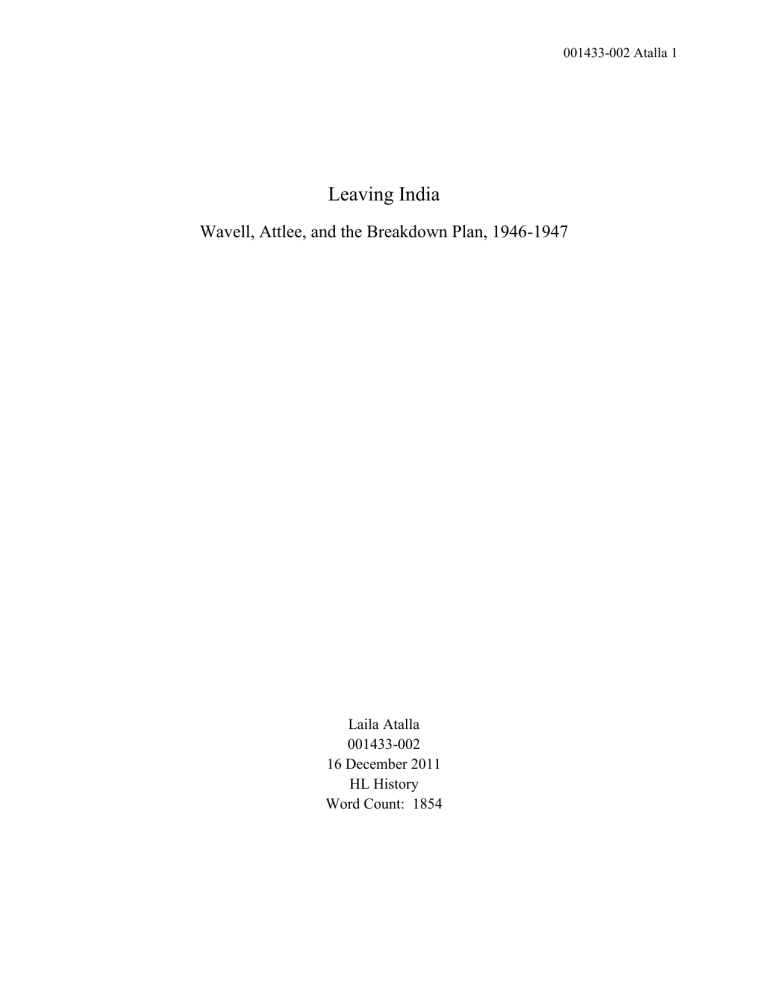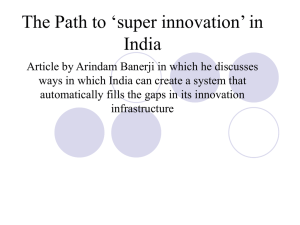001433-002 Atalla Leaving India Wavell, Attlee, and the Breakdown

001433-002 Atalla 1
Leaving India
Wavell, Attlee, and the Breakdown Plan, 1946-1947
Laila Atalla
001433-002
16 December 2011
HL History
Word Count: 1854
001433-002 Atalla 2
A SUMMARY OF PLAN OF INVESTIGATION
This investigation examines the process of Indian independence from Britain as it was envisioned by Lord
Archibald Wavell, the penultimate Viceroy of India, and as it was carried out by Prime Minister Clement
Attlee, contrasting the two men’s goals for the transfer of power. An examination of Wavell’s
Breakdown Plan and its differences with the partition plan ultimately enacted by Attlee reveals that actual Indian independence was a hasty process that emphasized a quick withdrawal over a steadier, more gradual transfer of power.
Wavell’s journal and Attlee’s interviews and memoirs are used to examine each figure’s opinions on the process and the Breakdown Plan in particular.
1 Secondary sources on Indian independence and the end of the British Empire provide the context.
2 This investigation focuses solely on Wavell’s and Attlee’s differences regarding the Breakdown Plan, which represented a new phase in the approach to the transfer of power after the failure of the Cabinet Mission.
B SUMMARY OF EVIDENCE
Wavell, who served as Viceroy from October 1943 to March 1947, was committed to involving both the
Indian National Congress and the Muslim League in a settlement on independence before the end of
World War II.
3 However, British attempts to reach such an agreement before WWII ended, including
Wavell’s June 1945 Simla Conference, failed, as did the post-war Cabinet Mission of March to June
1946.
4 By October 1946, Wavell was convinced that Britain’s options in India were very limited.
5 The
Viceroy perceived four possible British routes of action in India: attempt to hold on to India indefinitely by force, try to create a new agreement between the League and the Congress, give in to the Congress party, or withdraw from the country without reaching a settlement.
6 The final choice, withdrawal without
1 Clement Attlee, As It Happened (New York: Viking Press, 1954); Archibald Wavell, Wavell: The Viceroy’s
Journal , ed. Penderel Moon (London: Oxford University Press, 1973); Francis Williams, A Prime Minister
Remembers: The War and Post-War Memoirs of the Rt. Hon. Earl Attlee, Based on his PrivatePapers and on a
Series of Recorded Conversations (London: Heinemann, 1961).
2 R. J. Moore, Escape from Empire: The Attlee Government and the Indian Problem (Oxford: Clarendon Press,
1983); Ronal Lewin, The Chief: Field Marshal Lord Archibald Wavell, Commander-in-Chief and Viceroy, 1939-
1947 (New York: Farrar, Straus, Giroux, 1980); Peter Clarke, The Last Thousand Days of the British Empire:
Churchill, Roosevelt, and the Birth of the Pax Americana , 1 st American ed. (New York: Bloomsbury Press, 2008).
Yasmin Khan, The Great Partition: The Making of India and Pakistan (New Haven, CT: Yale University Press,
2007); Rajeev Bhargava, “India,” Dissent 56 (2009); Arthur Herman, Gandhi and Churchill: The Epic Rivalry That
Destroyed an Empire and Forged Our Age (New York: Bantam Books, 2008).
3 Lewin, Chief , 233 and Wavell, Journal , 98. Wavell explained to Churchill in an October 1944 letter that after
World War II Indian political prisoners would be released, food shortages and unemployment would cause unrest, and it would be more difficult for the British to maintain the firm control of India needed for the independence process.
4 Lewin, Chief , 233-235 and Wavell, Journal , 227-315. In June 1945 Wavell organized the Simla Conference, which brought together all Indian political leaders to discuss possible plans for independence. This failed largely due to tensions between the Muslim League and the Congress Party. The Cabinet Mission of 1946 was sent by
Attlee, then Prime Minister, to reach a settlement on independence. This too failed in part because of divisions between Indian political groups.
5
Wavell, Journal , 368.
6 Wavell, Journal , 344-345. Wavell wrote that the first option, using force, had already been “ruled out as politically impossible,” and moreover would be difficult for a Britain weakened by WWII. The second, creating a new settlement, was undesirable as it was would surely involve a partition into Hindu and Muslim states and force the
British to stay in India to enact it. Surrendering to Congress, the third option, was not “an honourable or a wise
001433-002 Atalla 3 settlement, was not ideal; however, it was the most realistic plan of action for the British, and thus became the basis of Wavell’s views on the transfer of power as embodied by the Breakdown Plan.
7
The Breakdown Plan involved setting a date for final British withdrawal from India, and systematically pulling out by that time if no agreement was reached.
8 Significantly, the true goal of the Breakdown Plan was not to allow for British withdrawal without reaching a settlement; rather, Wavell wanted to use the plan to pressure the Congress Party and Muslim League to come to an agreement. Until the date of withdrawal, Britain would continue negotiations for transfer of power to a united India, and the set independence date would grant more urgency to the talks.
9 Initially, the British would leave only four of
India’s six southern provinces; the remaining southern provinces and the Muslim-dominated regions would be occupied until March 31, 1948 in order to make the transfer of power as orderly as possible, make sure that provincial governments established authority, and protect minorities.
10 The still occupied
Muslim provinces would be encouraged to unite with independent India rather than form a Pakistan.
11
When presented with Wavell’s views, Clement Attlee, who became Prime Minister in June 1945, initially did not believe that the British position in India was so dire, and perceived the Viceroy and his advisors as
“despondent” and “pretty defeatist.” 12 At the Viceroy’s December 1946 visit to London, during which
Wavell presented the Breakdown Plan to the Cabinet, Attlee was informed of the true weakness of the
British position in India, and at several points “seemed prepared to accept [the Breakdown Plan] in principle.” 13 However, Attlee’s Cabinet ultimately decided that the Breakdown Plan was too extreme and could not be used, as Wavell intended, to put pressure on the Indian parties to reach an agreement.
14 The
Cabinet rejected the plan in January 1947, and Attlee dismissed Wavell in March.
15
Despite his rejection of Wavell’s Breakdown Plan, the deteriorating situation in India eventually brought
Attlee to the conclusion that realistically “the only thing to do was to set a time-limit and say: ‘Whatever happens, our rule is ending on that date.’” 16 To this end, Attlee sent the new Viceroy, Lord Louis
Mountbatten, to India with the express understanding that “he was going out not to continue the British
Raj but to end it.” 17 On the surface, Attlee’s course of action resembled closely the Breakdown Plan; however, Attlee’s plan involved withdrawing quickly from all of India at once, keeping only limited numbers of troops in India, moving the independence date forward to August 1947, not insisting on a united India, and not giving lengthy notice of the independence plan.
18 These points became the basis of the course that Indian independence ultimately followed. Carried out over 73 days by Mountbatten, the transfer of power involved complete withdrawal at a fast pace, and resulted in the partition of the former policy” as it would “end British rule in India in discredit and eventually in an ignominious scuttle or dismissal by
Congress.”
7 Wavell, Journal , 344, 388-389. Wavell had first mentioned this plan to the Secretary of State in September 1946.
8 Wavell, Journal , 399. Wavell suggested March 31, 1948 as the deadline for Indian independence
9 Wavell, Journal , 389, 344.
10 Wavell, Journal , 344-345.
11 Moore, Escape from Empire , 186.
12 Attlee, As It Happened , 257; Wavell, Journal , 344; Williams, Prime Minister , 209.
13 Wavell, Journal , 392.
14 Moore, Escape from Empire , 183.
15 Herman, Gandhi and Churchill , 560 and Wavell, Journal , 397.
16 Williams, Prime Minister , 208.
17 Williams, Prime Minister , 210.
18 Moore, Escape from Empire , 190-192, 354; Wavell, Journal , 345; Williams, Prime Minister , 210.
001433-002 Atalla 4 colony into India and Pakistan, widespread violence, and the displacement of approximately 5.8 million
Muslims and 5.5 million Hindus and Sikhs.
19
C EVALUATION OF MAIN SOURCES
While he was Viceroy, Wavell kept a near-daily journal in which he recorded political events, his actions and interactions with other main figures in Anglo-Indian relations, and his opinions of what was happening in India, as well as some of his correspondence and other documents. Wavell wrote that although he never kept a diary before his Viceroyalty, his participation in WWII made him “[regret] that
[he had] not kept a note of certain happenings and conversations” and prompted him to “try to put down at the time some note of matters and impressions which may be of interest from the personal or historical point of view.” 20 He clearly understood that the events in which he was involved would have a lasting effect on the future and wanted to make his role in and thoughts on such events available for future historians. In relation to this investigation, Wavell’s journal is valuable in that it shows in detail how the idea of a Breakdown Plan germinated and evolved, highlighting Wavell’s basic belief that withdrawal from India needed to be gradual enough to establish a stable state. The journal’s scope is limited, though, by the fact that Wavell stopped writing in it for several months after his dismissal, and thus did not provide commentary on the way that Indian independence actually played out.
In relation to Attlee’s views on the transfer of power, a collection of Attlee’s correspondence and interviews are critical to this investigation. Published in 1961, ten years after the end of his service as
Prime Minister, A Prime Minister Remembers is based partly on interviews from a 1959 BBC series produced as a retrospective on Attlee’s career.
21 The source gives insights into Attlee’s evolution of thought on Indian independence and the divergence on policy that he and Wavell experienced, complementing Wavell’s journal to provide an alternative viewpoint on the Breakdown Plan. However, the limitations of this document lie in the fact that the interviews were meant for a public television audience rather than a scholarly audience, so Attlee’s discussion of Indian independence is somewhat simplified. Additionally, Attlee was doubtless trying to portray his term favorably by emphasizing the successes of his approach to the transfer of power, so bias is present. Nonetheless, the source is valuable for its presentation of Attlee’s views.
D ANALYSIS
Although Wavell’s Breakdown Plan was never put into action, the details of the plan reveal an emphasis on securing an orderly transition of power that was lacking in the partition plan that Attlee ultimately supported. Wavell’s priority was to extract the British from India while ensuring that independence was as orderly and peaceful as possible and that power was transferred to a viable new government. To this end, the Breakdown Plan involved gradually evacuating on a systematic province-by-province basis to pass authority to local governments, maintaining a military presence in several provinces for some time,
19 James, Raj , 635-638.
20 Wavell, Journal , xiv.
21
Williams, Prime Minister , vii. The program was received well by the British public.
001433-002 Atalla 5 and encouraging the establishment of a united India. In Wavell’s opinion, a more costly, prolonged withdrawal process was worth a peaceful transfer of power to a viable government. While Attlee did ultimately come to agree that something like a Breakdown Plan was needed to withdraw the British from
India, he differed from Wavell in that he was not willing to commit to a more drawn-out independence process. This is illustrated in the fact that Attlee’s plan for withdrawal called for the evacuation of all of
India at once, involved only limited military presence, and, significantly, moved the independence date forward a year to August 1947.
22 These differences show that Attlee prioritized speedily ending Britain’s
Indian problem over securing order in withdrawal. Ultimately, Attlee was willing to accept partition in exchange for such a withdrawal.
In fairness to Attlee, his position as Prime Minister, an elected official subject to public opinion, did play a significant role in causing his goals for independence to be different from those of Wavell. Attlee recognized that a quicker, less costly solution to the Indian problem would be more popular with most of the British public than would the more gradual withdrawal suggested by Wavell. Additionally, Attlee’s support of the partition plan may have been motivated in part by the belief that British interests in South
Asia would be better served by the presence of a smaller, more malleable Pakistan than by the existence of a united India.
23 Wavell, by contrast, was a military officer who most likely weighed the conditions on the ground over British public opinion in developing his views. Moreover, Wavell’s years of residency and travel in India, replete with interactions with the Indian population he governed, instilled Wavell with a concern for the Indian people that Attlee did not seem to share.
Some historians, and indeed the British public and many politicians at the time, praised Attlee’s speedy resolution of the Indian problem for keeping the British from becoming bogged down in a protracted struggle.
24 However, the fact remains that British withdrawal from India has been condemned by many historians as hasty, reckless, and largely responsible for the violence that occurred in the aftermath of the partition; one study states that the partition “delivered one of the worst human calamities of the twentieth century.” 25 From this investigation, it is evident that Attlee’s prioritization of a speedy finish, rather than a gradual transition, contributed to these issues. Wavell’s plan contained aspects that anticipated many of the problems that arose in the aftermath of independence, but his dismissal prevented this plan from being used.
E CONCLUSION
Comparison of Wavell’s and Attlee’s plans for Indian independence reveals a divergence on whether ensuring an orderly transfer of power or securing a speedy withdrawal was more important. Wavell’s
Breakdown Plan prioritized a peaceful transition to a viable local government and called for a gradual, systematic withdrawal to accomplish this. In contrast, Attlee made a quick resolution to the Indian
22 Moore, Escape from Empire
, 354 and Bhargava, “India,” 40.
23 Bhargava, “India,” 40.
24 Williams, Prime Minister , 202, 215. Letters from Attlee’s contemporary politicians show the support his plan received at the time.
25 Khan, Partition , 5. Khan roundly condemns the partition plan as reckless and unnecessarily destructive.
Bhargava shares the view that Britain must bear the brunt of the responsibility for the violence that broke out following independence, and James also questions whether the independence process was too fast-paced.
001433-002 Atalla 6 problem his priority and supported a more rapid, less costly independence process. Each man was subject to different influences based on his positions and publics, and these factors were reflected in their contrasting visions of Indian independence. Ultimately, Wavell was dismissed and his Breakdown Plan rejected, and Attlee’s faster-paced withdrawal plan was implemented, contributing to the violence and chaos that accompanied Indian independence.
1,845 words
001433-002 Atalla 7
F BIBLIOGRAPHY
Primary Sources
Attlee, Clement. As It Happened . New York: Viking Press, 1954.
Wavell, Archibald.
Wavell: The Viceroy’s Journal
. Edited by Penderel Moon. London: Oxford
University Press, 1973.
Williams, Francis. A Prime Minister Remembers: The War and Post-War Memoirs of the Rt. Hon. Earl
Attlee, Based on his Private Papers and on a Series of Recorded Conversations . London:
Heinemann, 1961.
Secondary Sources
Bhargava, Rajeev. “India.” Dissent 56, no. 1 (Winter 2009): 40-43.
Clarke, Peter. The Last Thousand Days of the British Empire: Churchill, Roosevelt, and the Birth of the
Pax Americana. 1 st American edition. New York: Bloomsbury Press, 2008.
Herman, Arthur. Gandhi and Churchill: The Epic Rivalry That Destroyed an Empire and Forged Our
Age . New York: Bantam Books, 2008.
Khan, Yasmin. The Great Partition: The Making of India and Pakistan.
New Haven, CT: Yale
University Press, 2007.
Lewin, Ronald. The Chief: Field Marshal Lord Wavell, Commander-in-Chief and Viceroy, 1939-1947 .
New York: Farrar, Straus, Giroux, 1980.
Moore, R. J. Escape From Empire: The Attlee Government and the Indian Problem . Oxford: Clarendon
Press, 1983.







